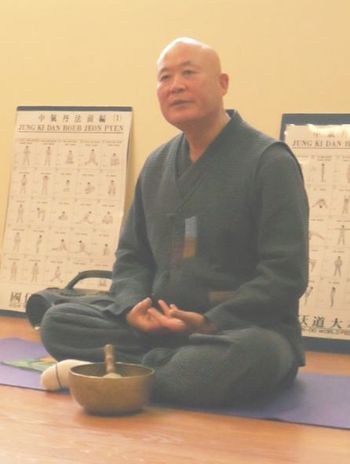A Taoist Master on Mindfulness and Empty Mind
|
Over 9,000 years ago, the shamans of tribes inhabiting a mountainous strip of land that would one day be known as Korea, discovered a sacred wisdom practice — one that leads to a profound unity of the mind, body, and spirit, and a deep oneness with nature. In the chaotic times of change in 9th century, these sages feared their discipline might become compromised, so they retreated to the most far-off mountains of their land where they could engage in solitary practice and insure the faithful survival of their art. This discipline became known as SunDo, or Mountain Taoism, and was passed down from teacher to student by the descendants of those ancient shamans. These lineage-holders became powerful Taoist masters able to cultivate and direct Qi at will for healing and longevity. |
SunDo, as we call it today, had quietly remained just out of reach of the common person until 1967, when these Taoist masters in the mountains determined that their discipline was needed for the benefit of humanity. At this time they sent Chung-san, who was given a new name as Bekyung (Secret Boundary), down from the mountains to live among his fellow people and train anyone who was willing to work with him and learn the practice of SunDo.
Of these willing individuals, 11 were given the title of master — a teacher of the highest order, sanctioned by Grandmaster Bekyung himself. One of these adepts was Taoist Master Hyunmoon Kim, the man who brought SunDo to the West.
|
Ancient wisdom reaches the modern master SunDo and its masters are a true rarity — they represent an ancient practice and timeless wisdom, undiluted in its transfer throughout the ages. Master Kim, SunDo’s ambassador to the West, embodies the care and authenticity that has kept the art every bit as powerful and relevant in the modern day as it was in the earliest reaches of recorded history. SunDo has been accurately passed down from mountain sage, to teacher, to students for thousands of years. The personal relationships every SunDo teacher in The United States and Europe have with Master Kim, as well as his availability to students across the these territories are clear examples of the primary source-instruction that sets SunDo apart from so many of its modern counterparts. |
Master Kim’s Philosophy — the distinction between mindfulness and inner focus
For most of our lives, we rely on our senses to help us navigate our way through the world. However, we notice many instances where the limitations of the these tools become very clear. Sight cannot help us to “see the truth,” and our ears cannot hear the deepest desires of our hearts. Our senses are tools for the outer world, but what if the insights we need lie within? And worse yet, what if our senses are actually getting in the way of this big-picture knowledge?
A Taoist proverb reads:
Colors blind the eye.
Sounds deafen the ear.
Flavors numb the taste.
Thoughts weaken the mind.
Desires wither the heart.
The master observes the world
but trusts his inner vision
He allows things to come and go.
His heart is open as the sky.
Sounds deafen the ear.
Flavors numb the taste.
Thoughts weaken the mind.
Desires wither the heart.
The master observes the world
but trusts his inner vision
He allows things to come and go.
His heart is open as the sky.
This is a major point of distinction in Taoism and Master Kim’s philosophy within it. In other schools of yoga, like the Buddhist tradition, mindfulness is the goal — what Master Kim defines as being “full of mind.” This is the relaxed state of detached clarity achieved in basic meditation forms. Practitioners are aware of their senses, but do not use them for judgment and accept them as they are. There are clear benefits to the calmness and self-control that stem from mindfulness, particularly in our day-to-day work in the outer world.
|
Awareness of our senses, however, keeps us in a consistent state of in-the-moment consciousness — in order to find our deepest self-awareness and tranquility, we need to let go of our senses and move beyond the conscious mind to bring the subconscious to light.
This can only be achieved by emptying the mind of thought and sensory input. By depriving the “monkey mind,” we open a gate to deeper meditation and can experience the “universal mind” — a mind that can be imagined as an all-pervading energy flow, which some call Tao. The Intuitive wisdom teachings of Hyunmoon Kim |
Breath is the bridge between the conscious and subconscious as well as the unifying force of the mind, body, spirit. By retreating from the senses and shifting our focus inward we are able to “empty the mind,” not only of the distractions around us, but the nagging, persistent thoughts lingering in the shadows. SunDo’s consistent, deep belly breathing is the most powerful and reliable way to achieve this state.
Additional Reading: Why Focused Breathwork Is More Effective Than Unfocused Breath Meditation.
SunDo cultivates “intuitive wisdom” — a skill essential to living a long and good life, but one we are seldom taught in modern society. The long-held postures and rhythmic breathwork Master Kim develops in the discipline, teaches practitioners to apply this intuition to all parts of their bodies, awakening a deep understanding of how to use their minds, spirits, and physical energy centers to the fullest capacity.
Breath is the bridge between the conscious and subconscious as well as the unifying force of the mind, body, spirit. By retreating from the senses and shifting our focus inward we are able to “empty the mind,” not only of the distractions around us, but the nagging, persistent thoughts lingering in the shadows. SunDo’s consistent, deep belly breathing is the most powerful and reliable way to achieve this state.
Additional Reading: Why Focused Breathwork Is More Effective Than Unfocused Breath Meditation.
SunDo cultivates “intuitive wisdom” — a skill essential to living a long and good life, but one we are seldom taught in modern society. The long-held postures and rhythmic breathwork Master Kim develops in the discipline, teaches practitioners to apply this intuition to all parts of their bodies, awakening a deep understanding of how to use their minds, spirits, and physical energy centers to the fullest capacity.
|
“Each posture awakens the wisdom of life which is stored in different parts of the body,” Master Kim says. Read the article, SunDo: At One With Nature and a Mountain Taoist Master, for more on Master Kim’s description of SunDo’s postures and stages of Qi (spiritual) development.
In the next blog we will dive deeper into Master Kim’s life and teachings as well as his work in constructing a Taoist healing retreat center in the heart of Vermont’s Northeast Kingdom. |
1 Tao Te Ching, Stephen Mitchell, 1988




